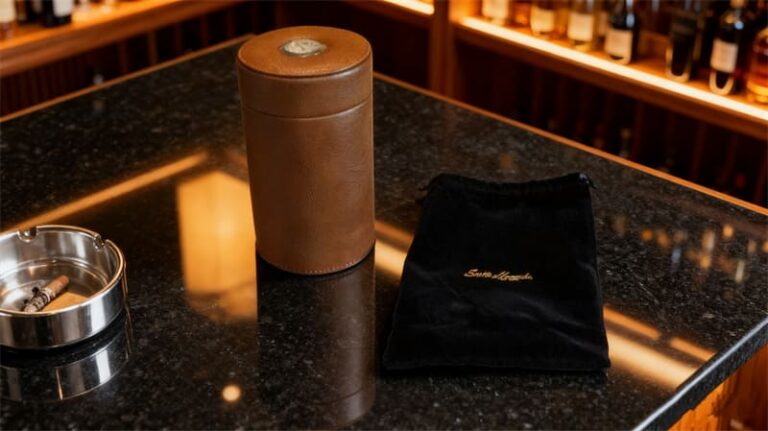What Is a Cigar Humidor and How Does it Work?
Look, whether you say “humidor” or “umidor,” we all mean the same thing, and it’s a question I get all the time from friends just getting into the hobby. At its core, a humidor is just a storage container. But it’s not just any box—it’s a climate-controlled safe-deposit box designed for one job and one job only: keeping your cigars perfectly fresh by nailing the humidity and temperature.
You gotta understand, tobacco leaf is basically a sponge. It’s ‘hygroscopic,’ which is just a fancy way of saying it sucks up moisture from the air and lets it go just as easily. I learned this the hard way when I left a really nice stick my friend Desmond gave me on my desk… two days later, it smoked harsh, bitter, and fast. A total waste. The wrong humidity, high or low, will absolutely wreck the flavor profile that the roller intended.
So, what’s this box for? It’s where your cigars live. It’s their home. If you just leave your prized collection out in the open, they’ll dry out in days, turning into brittle, tasteless sticks. A good humidor doesn’t just store them; it keeps them in that perfect ‘just-rolled’ state. And just as important, it lets them age properly. A cigar that’s been aged for a year in a stable environment? That’s a next-level experience.
What Does a Cigar Humidor & Humidifier Do?
Think about where the world’s best cigars come from. You’re picturing Cuba, the Dominican Republic, Nicaragua, right? My buddy Nolan just got back from a trip to the DR and told me the air was so thick and warm you could practically drink it. That’s the climate these tobacco leaves were born in and love. Since most of us don’t live in a tropical paradise, we need a box that can fake it.

The ‘humidifier’ is the engine of the whole setup. This is the little device—it could be a simple sponge, some crystal gel, or a high-tech electronic unit—that slowly and steadily releases moisture into the box. We’re all chasing that ‘sweet spot,’ which for most of us is around 65-75% relative humidity and a temperature somewhere between 65-75°F. That’s the magic window. The humidification unit is, hands down, the most critical piece. It has to be the right size for your box and the number of cigars you’re stuffing in there.
How Does a Humidor Work?
So how does the box actually hold that perfect, tropical climate? It all comes down to two things: a great seal and quality materials. A well-made humidor closes with a solid ‘whoosh’ sound—that’s how you know it’s airtight. And the inside? Spanish cedar. It’s the gold standard for a reason. The second you open a good humidor, that amazing, spicy aroma just hits you. It’s not just for show; that wood is fantastic at holding and regulating moisture, and it just belongs with tobacco.
Most humidors come with a ‘dashboard.’ You’ll almost always see a little gauge called a hygrometer—its only job is to tell you the humidity level inside. If you’ve got a fancier electric model, it’ll also have a thermostat to control the temperature. Honestly, having both makes life so easy. You can just peek at the numbers on the display and know your collection is safe, sound, and happy.

What are the Types of Humidors?
Okay, so ‘humidor’ isn’t just one thing. I’ve seen guys who just want to keep five sticks fresh for the weekend, and I’ve seen guys who are cellaring 2,000. Your budget, your collection size, and your needs totally change the game. They come in all shapes, sizes, and materials, from simple desktop boxes to full-on, high-tech cabinets.
Desktop Humidors
This is what everyone starts with, and for good reason. It’s your classic, beautiful box that sits on your desk, your bookshelf, or your bar. My first one was a simple wooden box my wife, Maren, got me for my birthday, and it held about 50 sticks. They can be all wood, have a glass top so you can admire your collection, or even be made of acrylic.
The biggest plus is just… having it right there. It looks awesome, and your collection is always within arm’s reach. But I gotta be real, you have to be careful with them. If you get one with a glass top, you cannot let it sit in direct sunlight. The sun will absolutely bake your cigars, even inside the box, and can throw your humidity levels into chaos. I learned that one the hard way.
Cabinet Humidors
Then you’ve got the guys who go big. My friend Reid has one of these in his office, and it’s a total beast. We’re talking cabinet humidors. These are for serious collectors who have more cigars than they know what to do with. They look like legit pieces of furniture—like a wine fridge or a small wardrobe—and can hold 300, 500, or even thousands of cigars, all arranged on different shelves.

Obviously, the huge win here is the storage capacity. You can organize everything by brand, age, or wrapper. But the downside is just… the sheer size and weight. When Reid had to move apartments last year, he said moving that cabinet was an absolute nightmare. It’s a real commitment, both in space and cost.
Travel Humidors
This one’s a complete no-brainer if you ever leave the house with your cigars. They range from tiny, pocket-sized cases that hold just two or three for a night out, to what are basically reinforced, military-style briefcases that can hold a couple of hundred for a trade show or a big event.

Their whole point is to take a beating. I take a small 10-stick one on every camping or fishing trip. It’s basically a crush-proof, shatter-proof little tank. Mine is waterproof, too, which has come in handy more than once. It keeps my cigars safe and humidified, no matter if it’s rattling around in the back of the truck or sitting next to the cooler by the fire.
Humidor Jars
You’ve probably seen these around, especially at cigar shop counters. They’re usually heavy glass or thick acrylic jars, kind of like an old-school cookie jar, that can hold maybe 15-20 cigars standing on end. They can look pretty cool on a bar cart, and I’ve found that most of them have a surprisingly good, tight-sealing lid.

Electric Humidors/Wineadors
This… this is what I’m saving up for. Electric humidors, or ‘wineadors’ (since they’re often built like wine fridges), are the ‘set it and forget it’ solution. These are for folks who really value their collection and want zero guesswork. You just plug it in, use a digital display to set the exact temp and humidity you want, and the machine does all the work. It heats, it cools, it humidifies. It’s the ultimate convenience, especially if you live somewhere with wild weather swings. I’ve had my eye on one of those new Smoke Dock units; they look absolutely incredible.

Walk-In Humidors
And then… there’s the dream. The holy grail. The walk-in humidor. It’s exactly what it sounds like: an entire room, lined with Spanish cedar, packed with shelves and boxes of cigars. This is what your local cigar shop has. It’s all run by a heavy-duty, commercial-grade electronic humidification system. One day, Wesley, one day…

How to Use a Humidor for Cigars?
Okay, this part is critical. Listen up. You can’t just buy a new humidor, toss your cigars in, and call it a day. If it’s lined with that beautiful Spanish cedar (and it should be), you must season it first. Think of it like priming a canvas before you paint, or seasoning a new cast-iron skillet. If you don’t, that bone-dry cedar will suck all the moisture out of your precious cigars, ruining them. Seasoning just means getting the wood itself stable and properly humidified before you introduce your collection.
Also, where you put your box matters. A lot. Keep it away from radiators, A/C vents, or windows. I made this mistake with my first desktop—left it on a windowsill where it got that hot afternoon sun. The temperature swings were brutal. Heat and sun are your enemies; they can lead to mold or, even worse, wake up the dreaded tobacco beetles. That’s a horror story you don’t want to live through.
Once you’re all set up, you’re not totally done. This is a living, breathing ecosystem. You’ve gotta keep an eye on that hygrometer. I check mine every few days just to make sure it’s holding steady. Depending on where you live and the season, you’ll probably need to re-season the box a couple of times a year (I do mine in the spring and fall) and make sure your hygrometer is calibrated so it’s not lying to you. It’s a little bit of care, but it’s worth it.



![NewAir CC-300H Humidor Review [No Bias] 10 NewAir CC-300H Humidor Review](https://smokedock.com/wp-content/uploads/2025/11/NewAir-CC-300H-Humidor-Review1-768x431.jpg)


